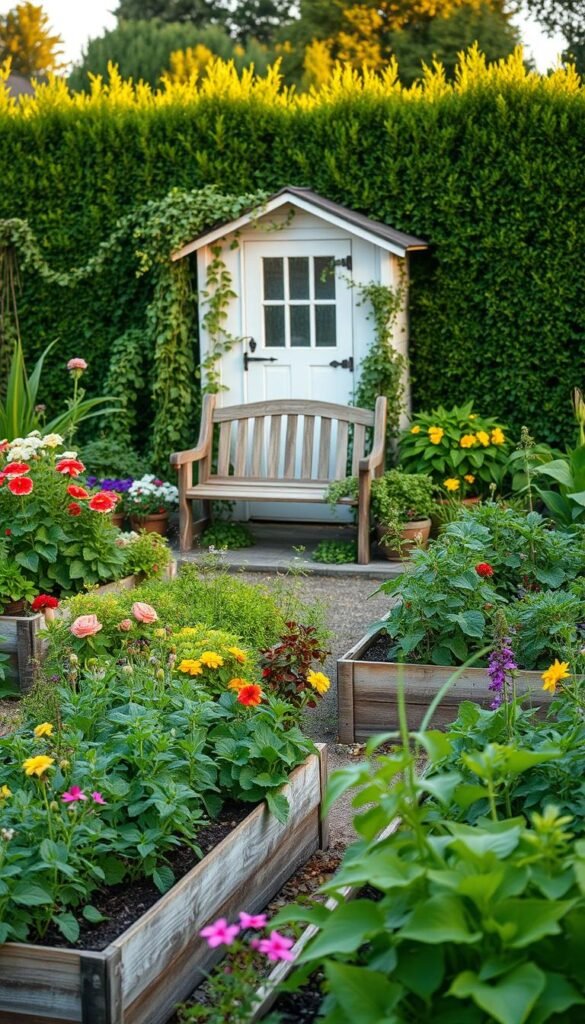Like your favorite TikTok trends, your outdoor space deserves a fresh look that’s both stylish and affordable. You don’t need endless funds to create a vibrant yard—just creativity and smart planning. This guide shows you how to transform your landscape with wallet-friendly solutions that make a big impact.
Whether you’re working with a small patio or a sprawling lawn, there’s something here for every space. Discover how repurposing materials, choosing low-maintenance plants, and tackling simple projects can breathe new life into your surroundings. These ideas balance practicality with visual appeal, so you won’t sacrifice style for savings.
From beginner-friendly upgrades to slightly more involved projects, you’ll find options tailored to your skill level. Learn how to use cost-effective supplies like gravel, pallets, or thrifted decor to craft unique features. Even minor changes—like rearranging pots or adding strategic lighting—can create a polished look.
Ready to turn your yard into a personalized retreat? Let’s explore how small efforts and clever choices can deliver stunning results. Your dream outdoor space is closer than you think!
Setting the Foundation: Budget and Design Goals
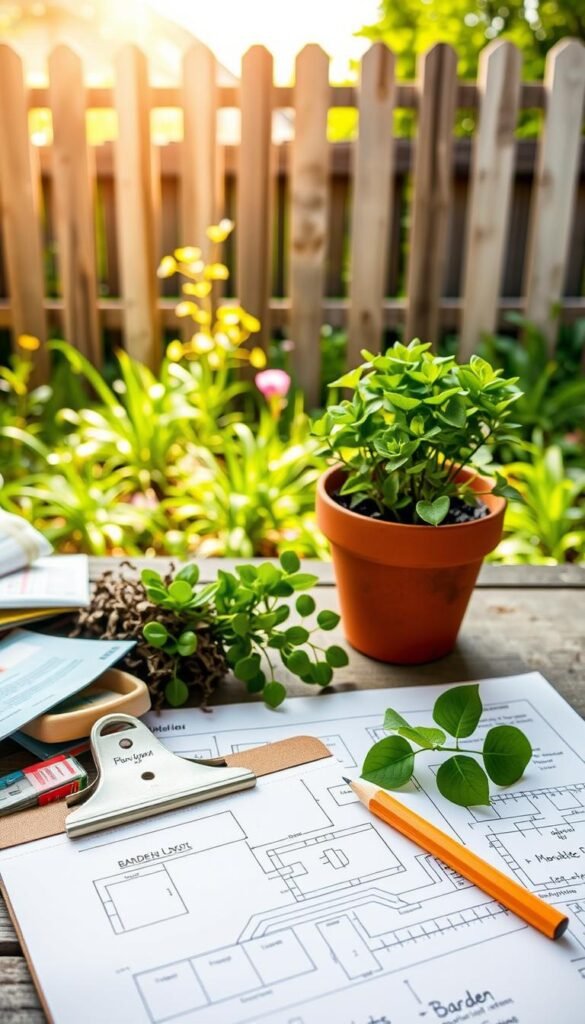
Great landscaping starts with understanding what you have and what you can achieve. Before grabbing tools, take time to map out your vision while keeping costs manageable. This approach helps avoid common pitfalls like overspending or mismatched elements.
Assess Your Outdoor Space
Walk through your yard and note sunlight exposure, drainage issues, and existing plants. Sketch a rough layout to visualize where changes matter most. For example, a shaded corner might work better for ferns than sun-loving flowers.
Budget-Friendly Planning Tips
Professional landscaping averages $4,000+ for installation, but smart DIY cuts costs dramatically. Start with high-impact projects like refreshing flower beds or creating home gardening ideas that won’t break the. Use this comparison to guide your choices:
| Project Type | Professional Cost | DIY Cost |
|---|---|---|
| Basic Design | $1,500-$5,000 | $0 (self-planned) |
| Planting Beds | $600-$2,000 | $100-$300 |
| Hardscaping | $3,000-$15,000 | $500-$2,500 |
Prioritize projects offering visual upgrades first. Focus on areas you use daily, like patios or entryways. Measure twice, buy once—accurate dimensions prevent wasted materials. Remember: even small tweaks like moving pots or adding mulch can refresh your space affordably.
Gathering Essential Gardening Supplies
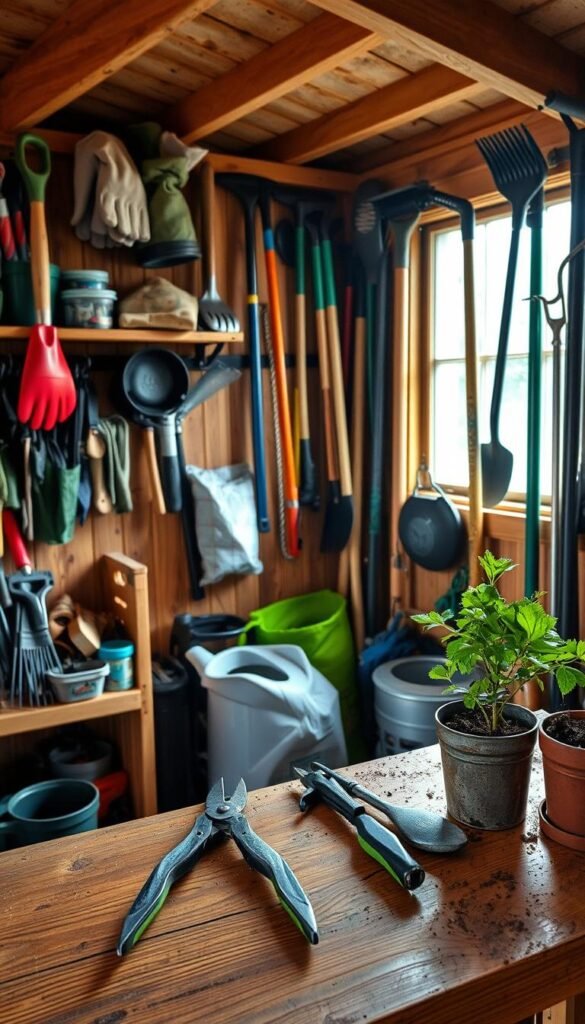
Smart gardeners know success starts with choosing the right foundation. Quality planters, nutrient-rich soil, and protective mulch form the backbone of any thriving outdoor space. Let’s break down how to source these essentials without draining your wallet.
Selecting Planters, Soil, and Mulch
Containers set the stage for your plants’ growth. Lightweight plastic pots work well for seasonal flowers, while ceramic options offer durability for perennials. Got old buckets or crates? Repurpose them into unique planters for herbs or succulents.
When buying soil, match your plants’ needs. Basic potting mixes ($5-$20 per bag) suit most flowers, while vegetable gardens thrive in compost-enriched blends. Check local nurseries for bulk discounts if you’re filling multiple containers.
Mulch does double duty—it retains moisture and elevates your garden’s look. Compare options below:
| Type | Cost (per cubic yard) | Best For |
|---|---|---|
| Wood chips | $20-$40 | Pathways & shrubs |
| Straw | $15-$30 | Vegetable beds |
| Shredded leaves | Free* | Flower borders |
Save more by grabbing free mulch from tree services or community programs. Pair these strategies with essential backyard gardening ideas to maximize both style and savings.
Creating a Captivating Focal Point for Your Garden
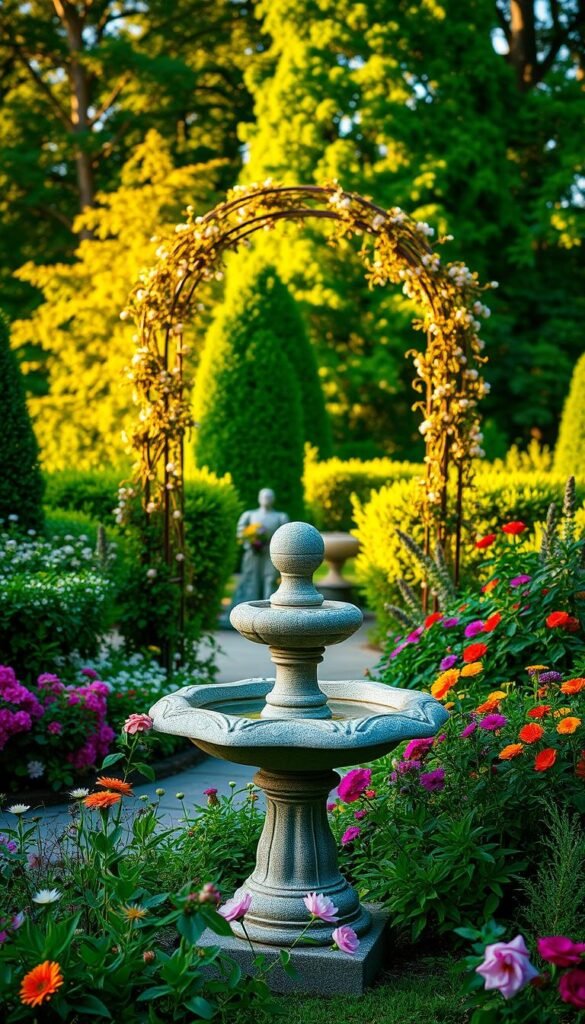
Every great outdoor space needs a star attraction that anchors the design. A well-chosen centerpiece guides the eye and adds personality to your layout. Best of all, you don’t need expensive installations—nature and creativity offer endless possibilities.
Building Functional Beauty With Trellises
Trellises work overtime as both decorative accents and plant supporters. Use fallen branches to craft rustic frames for climbing roses, or upcycle old ladders into vertical herb displays. Even basic PVC pipes can become modern structures for beans or ivy.
| Material | Cost Range | Best Use |
|---|---|---|
| Recycled wood | $0-$50 | Rustic designs |
| Metal grids | $30-$120 | Contemporary spaces |
| Bamboo poles | $15-$40 | Tropical themes |
Place your focal point where sightlines naturally converge—like at path endings or seating areas. A cluster of painted rocks or a weathered bench under a tree can create instant charm. Remember: scale matters. A small statue gets lost in open areas, while oversized elements overwhelm cozy corners.
For zero-cost options, arrange striking plants like red-twig dogwood or ornamental grasses as living sculptures. Group them in odd numbers for visual balance. These touches transform ordinary spots into conversation starters without redesigning your entire garden.
Transforming Outdoor Lighting with Solar and String Lights
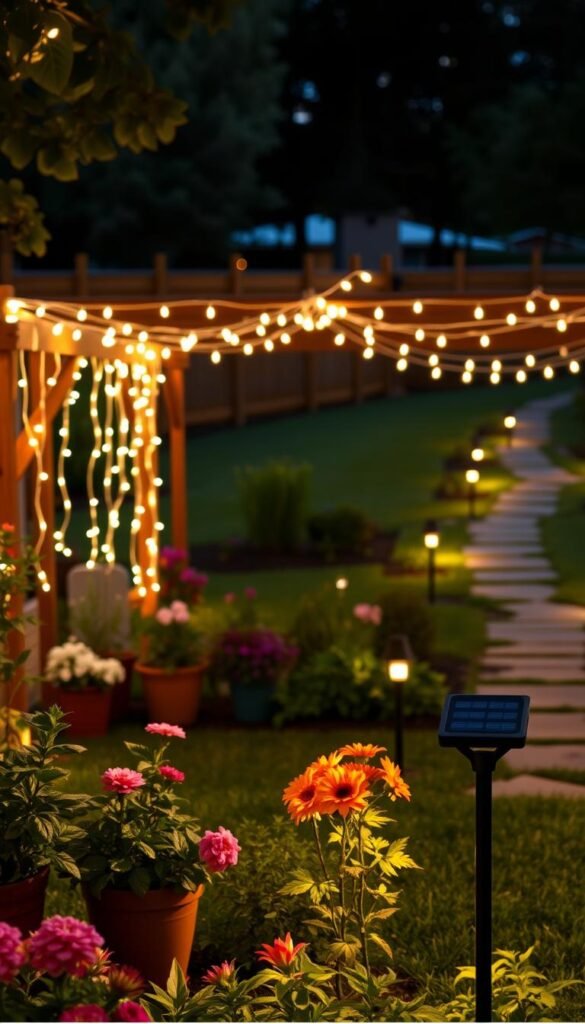
The right glow turns your yard into an evening oasis without rewiring your budget. Solar-powered lights and cascading string lights work together to create layers of warmth and functionality. These solutions let you enjoy your space after sunset while keeping energy costs low.
Budget-Friendly Lighting Options
Solar landscape lights start at just $10 each, making them accessible for any size project. Opt for models with dusk-to-dawn sensors to automate illumination. For larger areas, string lights costing around $80 per set add instant charm to patios or pergolas.
| Type | Average Cost | Best Placement |
|---|---|---|
| Solar path lights | $10-$25 each | Walkways & borders |
| Solar spotlights | $15-$40 each | Architectural features |
| LED string lights | $30-$80 per set | Overhead & vertical surfaces |
Installation Tips and Tricks
Create inviting patterns by zig-zagging string lights between posts or trees. Use screw-in hooks or zip ties for secure mounting—avoid nails that damage surfaces. Waterproof options withstand rain and humidity, ensuring year-round use.
Highlight existing garden elements by wrapping lights around tree trunks or lining steps with solar stakes. Mix warm white and amber tones to build depth. Remember: subtle lighting often makes the biggest impact after dark.
DIY Garden Beds and Raised Planters
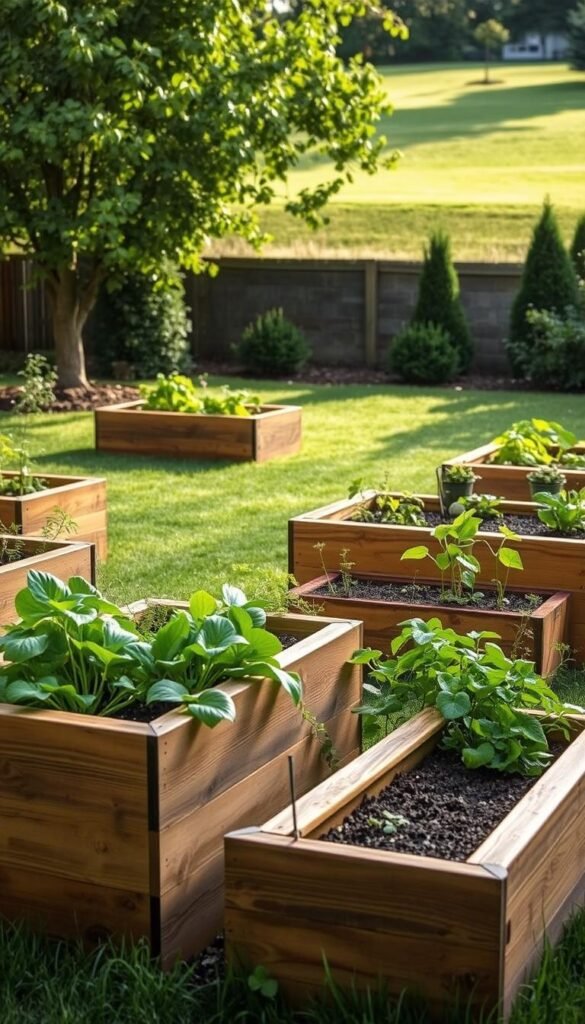
Elevate your growing game with raised beds that boost plant health and simplify maintenance. These structures give you complete control over soil quality while keeping weeds at bay. Better yet, you can build one for under $30 using materials like scrap wood or leftover bricks.
Why choose raised garden beds? They prevent soil compaction, improve drainage, and protect roots from pests. Unlike traditional plots, you won’t battle invasive grasses or need to till annually. Pair them with quality soil mixes for faster growth and higher yields.
Construction options adapt to any skill level:
| Material | Cost Per Bed | Durability |
|---|---|---|
| Pine boards | $15-$25 | 3-5 years |
| Cinder blocks | $20-$40 | 10+ years |
| Recycled bricks | $0-$30 | Lifetime |
Place beds where they’ll get 6-8 hours of sunlight daily. Keep paths between them at least 2 feet wide for easy access. For veggies, aim for 12″ depth—18″ if growing carrots or potatoes.
Turn functional planters into design stars by arranging them in geometric patterns or tiered layouts. Try building raised beds for square-foot gardening to maximize small spaces. Stain wooden frames to match your fence, or let moss grow on brick edges for rustic charm.
Incorporating Perennials and Annuals on a Budget
Stretching your plant budget starts with knowing which flowers give you the most bang for your buck. By blending long-lasting perennials with vibrant annuals, you create dynamic displays that evolve through the seasons. This approach keeps your space lively without constant replanting.
Choosing Low-Cost, High-Impact Plants
Focus on varieties that multiply or reseed themselves. Black-Eyed Susans and Coneflowers bloom year after year, while Zinnias and Marigolds deliver bold summer color for under $3 per packet. Compare popular options:
| Type | Cost Range | Bloom Period |
|---|---|---|
| Daylily (perennial) | $8-$15 | June-August |
| Sweet Alyssum (annual) | $2-$5 | Spring-Frost |
Seasonal Planting Strategies
Shop nurseries in late spring for discounted perennials that missed peak sales. In fall, grab marked-down annuals for final seasonal pops. Pair early-blooming Hosta with late-season Petunias for nonstop interest.
New to plant care? Our beginner’s checklist helps you avoid common mistakes. Remember: matching plants to your sunlight and soil conditions ensures they thrive—saving you replacement costs down the line.
Exploring Xeriscaping and Water Conservation Techniques
Cutting water use doesn’t mean sacrificing beauty—it’s about working smarter with what nature provides. Xeriscaping offers a blueprint for creating lush spaces that thrive in dry climates while slashing your water bill. This approach combines drought-resistant plants with strategic design to build resilient landscapes.
Start by swapping thirsty grass for native species like lavender or yucca. These plants evolved to handle local weather patterns, needing up to 60% less water than traditional lawns. Pair them with decorative gravel or river rocks to reduce areas needing irrigation.
Smart conservation techniques make every drop count. Drip irrigation systems target roots directly, wasting 50% less water than sprinklers. While pros charge $490+ for installation, DIY kits start under $50. Add 3 inches of mulch around plants to lock in moisture and suppress weeds naturally.
| Plant Type | Water Needs | Visual Appeal |
|---|---|---|
| Agave | Low | Architectural shape |
| Sedum | Minimal | Colorful groundcover |
| Russian Sage | Moderate | Airy purple blooms |
Hardscaping elements like flagstone paths or dry creek beds add texture while shrinking maintenance. These features prevent erosion during rare rains and create visual flow. Remember: successful xeriscaping balances practical techniques with personal style—your yard should reflect both ecological sense and creative flair.
Integrating Creative Hardscaping Ideas
Your yard’s backbone isn’t made of plants alone—durable structures give it lasting character. Strategic walkways and crisp edging create visual flow while reducing upkeep. These elements work like punctuation marks in your landscape design, guiding movement and defining spaces.
Designing Walkways That Last
Path materials range from budget-friendly to high-end. Pea gravel costs just $335 for a 50-foot path, while flagstone runs $2,480+. For flexible layouts, stepping stones let you create meandering routes through flower beds. Use this comparison to choose wisely:
| Material | Cost Per Sq.Ft | Installation Ease |
|---|---|---|
| Pea gravel | $1.50-$3 | Beginner-friendly |
| Concrete pavers | $3-$6 | Moderate skill |
| Natural stone | $15-$30 | Professional recommended |
Edge your paths with repurposed materials for instant polish. Stack flat stones vertically along borders, or press wine bottles neck-down into soil. These touches add personality while keeping mulch in place.
Proper base preparation prevents shifting. Dig 4-6 inches deep, add crushed rock, then sand before laying stepping stones. For gravel paths, install landscape fabric first to block weeds. Pair functional hardscaping with personalized craft accents to make spaces uniquely yours.
Embracing Upcycling and Repurposing for Garden Decor
Your backyard can become a gallery of creativity without a trip to the store. Everyday objects like buckets, teapots, or even worn-out boots gain new purpose when transformed into planters. This approach cuts waste while adding personality to your space.
Transforming Everyday Items into Planters
Start by hunting for unused items around your home. An old bicycle basket becomes a whimsical herb display, while cracked ceramic bowls turn into succulent arrangements. For larger projects, try converting wooden crates into tiered plant stands or paint tires for vibrant flower displays.
Key considerations when repurposing materials:
| Material | Preparation Needed | Cost Savings |
|---|---|---|
| Metal containers | Drill drainage holes | 100% (vs. new) |
| Plastic bins | UV-resistant paint | 80-90% |
| Wooden furniture | Weatherproofing sealant | 70% |
Always ensure proper drainage by drilling holes in containers. Use non-toxic paints if decorating surfaces that touch soil. For inspiration, explore vintage gardening makeover techniques that blend functionality with rustic charm.
Finish projects with outdoor-safe sealants to protect against rain. Group repurposed pieces in odd numbers for visual balance. A cluster of tin-can lanterns or a ladder-turned-vertical garden becomes instant conversation starters.
20 DIY Garden Ideas to Refresh Your Yard on a Budget
Your outdoor space becomes a canvas when you combine smart planning with resourceful creativity. By mixing thrifty plant choices with clever decor hacks, you craft a space that feels both intentional and inviting. Remember: small changes often create the most noticeable upgrades.
Focus on elements that serve multiple purposes. Repurposed containers add charm while housing herbs. Solar lights enhance safety and ambiance after sunset. Native plants thrive with less water, saving you time and money.
Group projects by impact level. Start with quick wins like refreshing mulch or rearranging pots. Then tackle slightly bigger tasks—building raised beds or installing stepping stones. This phased approach keeps momentum high without overwhelming your schedule.
Above all, let your personality shine through. Paint old furniture as bold statement pieces. Cluster hand-made trellises near seating areas. Every thoughtful touch transforms your yard into a reflection of your style. With these garden ideas, you’ll create lasting beauty that grows richer each season.

